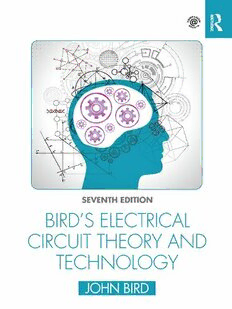
Bird's electrical circuit theory and technology PDF
Preview Bird's electrical circuit theory and technology
Bird’s Electrical Circuit Theory and Technology Whatskillsareneededforacareerinelectricalandelectronicengineering? When you decide to become an electrical or electronic engineer, you’re committing yourself to a profession that involves developing, designing, testing and supervising the manufacturing of electrical devices and equipment, includingnavigationsystems,electricmotorsandpowergenerationequipment.Therefore,tobeabletohandlesuch complexconceptsandtheories,andunderstandhowtoapplythemtoreal-lifeprojects,youneedtopossessaunique andtailoredskillset.Indeed,it’snosecretthatahighproportionofengineeringstudentsdropoutorchangecourse, withalackofpreparednessoftencitedasthebiggestreasonforthisunusuallyhighattritionrate. So,toseeifyouhavewhatittakestostaythecourseanddevelopapromisingcareerinthefield,herearethetop10 electricalandelectronicengineeringskillsthatyouwillneed. 1.Problem-SolvingSkills Regardlessoftheirdiscipline,engineersare,attheircore,problem-solvers.Thisisparticularlytrueinelectricaland electronic engineering, where you are often required to think logically and apply a particular rule or concept to a probleminordertosolveit. 2.BasicCircuitKnowledge Electrical design can become an extraordinarily complex topic, especially where large installations are concerned (suchasenergygrids),orevenwithinhighlyadvancedpiecesofsmallhardware,suchasthoseusedinsmartphones. Therefore,ifyouaretohaveanyhopesofgettingtogripswithitall,youneedtofirsthaveasolidunderstandingof basiccircuitdesign. SunshineSeeds/Shutterstock.com 3.EnthusiasmforLearning Althoughitisanessentialandunavoidablestep,havingadegreeorahighqualificationisnottheendoftheedu- cational road for an electrical/electronic engineer; in fact, it is just the beginning of your active learning journey. Muchofthisisborneoutofnecessity.Electricalandelectronicengineeringisoneofthefastestevolvingandfiercely competitiveengineeringfields,soyouwillneedtobeconstantlyuptodate(forexample,withIEEwiringregs,and particularlyifyouworkintheproductdesignandmanufacturingsector). 4.CommunicationSkills There is barely a profession in the world where the ability to communicate is not important, and electrical and electronicengineering is no different.Whether it’sunderstanding the needs and requirements of a client, working within project teams to develop or improve a piece of hardware/software, or working with other departments and stakeholders,communicationskillsareanessentialpartoftherole. 5.OrganisationalSkills Theabilitytoorganiseandmanageyourtimeisimportantforanelectrical/electronicengineer,asmuchofyourwork willlikelybetime-sensitiveorproject-based,regardlessofwhichareaofengineeringyouspecialisein. 6.NumericalSkills Acommonissueforelectricalandelectronicengineeringstudentsisthattheirmathematicalbackgroundisnotstrong enough. Therefore, it is important to focus on mathematics at college or university. Understanding engineering is extremelydifficultwithoutagoodknowledgeofmathematics. 7.WorkEthic A strong work ethic is another hugely important part of a successful engineer’s makeup. Therefore, you must be determinedandwillingtoworkuntilyoufindasolutiontowhatevertechnicalproblemsyouencounterinyourrole. 8.CriticalThinkingSkills Criticalthinkingisabroadskillthatcanbeappliedtoawidearrayofsituations,butitisjustasimportantinelectrical andelectronicengineering.Possessingtheabilitytoapproachthingsdifferentlyortakeadifferentviewtothenorm canmakeabigdifferencewhenyouaretryingtoachieveacertaingoalwithyourproject. 9.CreativeThinkingSkills Engineersarenotjustproblem-solvers-theyarepioneers.Whetherit’sonagrandscaleorasimpleone,thesolutions they provide change the way we live; therefore, to be able to explore and implement such radical ideas, you need tobeabletothink‘outsidethebox’.Thisisespeciallytrueinthecommercialsector,whereelectronicsgiantsare constantlycompetingtodevelopnewandexcitingtechnologies.Youcanhavealltheknowledgeintheworld,butif youdon’tknowhowtobecreativeandexplorenewpossibilitieswithit,thenyou’regoingtobeleftbehind. 10.ProgrammingSkills Althoughtheimportanceofprogrammingishigherinsomeareasofelectricalandelectronicengineeringthanothers, itisstillaveryusefulskilltopossess,particularlywhenworkingwithlow-levelembeddedsystemsorwhenanalysing data. Gorodenkoff/Shutterstock.com Asyoucansee,thecareerofanelectrical/electronicengineerisdemanding.Apartfrompossessingtherequisite technicalknowledge,itisalsomandatoryforyoutoincorporateotherkeysoftskillsintoyouremployability repertoire, such as decision-making, leadership and attention to detail. The rewards are high though, with electricalandelectronicengineeringoneofthehighest-payingsectorsintheindustry. Hopefully, Bird’s Electrical Circuit Theory and Technology will help you on your first important steps in a longcareerinelectricaland/orelectronicengineering. Thereisalottolearn;staywithit-itwillbeworthit. Bird’s Electrical Circuit Theory and Technology Nowinitsseventhedition,Bird’sElectricalCircuitTheoryandTechnologyexplainselectricalcircuittheoryandasso- ciatedtechnologytopicsinastraightforwardmanner,supportedbypracticalengineeringexamplesandapplications toensurethatreaderscanrelatetheorytopractice. The extensive and thorough coverage, containing over 800 worked examples, makes this an excellent text for a range of courses, in particular for Degree and Foundation Degree in electrical principles, circuit theory, telecom- munications,andelectricaltechnology.Thetextincludessomeessentialmathematicsrevision,togetherwithallthe essential electrical and electronic principles for BTEC National and Diploma syllabuses and City & Guilds Tech- nicianCertificateandDiplomasyllabusesinengineering.Thismaterialwillbeagreatrevisionforthoseonhigher courses. Thiseditionincludesseveralnewsections,includingglassbatteries,climatechange,thefutureofelectricityproduc- tionanddiscussionsconcerningeverydayaspectsofelectricity,suchaswattsandlumens,electricalsafety,ACvs DC,andtrendingtechnologies. Itscompanionwebsiteatwww.routledge.com/cw/birdprovidesresourcesforbothstudentsandlecturers,including fullsolutionsforall1400furtherquestions,listsofessentialformulae,andillustrations,aswellasfullsolutionsto revisiontestsforcourseinstructors. JohnBird,BSc(Hons),CEng,CMath,CSci,FIMA,FIET,FCollT,istheformerHeadofAppliedElectronicsinthe FacultyofTechnologyatHighburyCollege,Portsmouth,UK.Morerecently,hehascombinedfreelancelecturing attheUniversityofPortsmouthwithExaminerresponsibilitiesforAdvancedMathematicswithCity&Guildsand examiningfortheInternationalBaccalaureateOrganisation.Hehasover45years’experienceofsuccessfullyteach- ing,lecturing,instructing,training,educating,andplanningtraineeengineers’studyprogrammes.Heistheauthorof 146textbooksonengineering,scienceandmathematicalsubjects,withworldwidesalesofoveronemillioncopies. Heisacharteredengineer,acharteredmathematician,acharteredscientistandaFellowofthreeprofessionalinsti- tutions.Hehas recently retiredfrom lecturingat theRoyalNavy’sDefence Collegeof MarineEngineering inthe DefenceCollegeofTechnicalTrainingatH.M.S.Sultan,Gosport,Hampshire,UK,oneofthelargestengineering trainingestablishmentsinEurope. Besides this text, Electrical Circuit Theory and Technology 7th Edition, other books written by John Bird, and published by Routledge, include: • Bird’s Basic Engineering Mathematics 8th Edition • Bird’s Engineering Mathematics 9th Edition • Bird’s Higher Engineering Mathematics 9th Edition • Bird’s Comprehensive Engineering Mathematics 2nd Edition • Mathematics Pocket Book for Engineers and Scientists 5th Edition • Bird’sElectricalandElectronicPrinciplesandTechnology7th Edition • Science and Mathematics for Engineering 6th Edition • Mechanical Engineering Principles 4th Edition • Mechanics of Solids 3rd Edition Bird’s Electrical Circuit Theory and Technology Seventh Edition John Bird Seventheditionpublished2022 byRoutledge 2ParkSquare,MiltonPark,Abingdon,Oxon,OX144RN andbyRoutledge 605ThirdAvenue,NewYork,NY10158 RoutledgeisanimprintoftheTaylor&FrancisGroup,aninformabusiness ©2022JohnBird TherightofJohnBirdtobeidentifiedasauthorofthisworkhasbeenassertedbyhiminaccordancewithsections77and78of theCopyright,DesignsandPatentsAct1988. Allrightsreserved.Nopartofthisbookmaybereprintedorreproducedorutilisedinanyformorbyanyelectronic,mechanical, orothermeans,nowknownorhereafterinvented,includingphotocopyingandrecording,orinanyinformationstorageor retrievalsystem,withoutpermissioninwritingfromthepublishers. Trademarknotice:Productorcorporatenamesmaybetrademarksorregisteredtrademarks,andareusedonlyforidentification andexplanationwithoutintenttoinfringe. FirsteditionpublishedbyNewnes1997 SixtheditionpublishedbyRoutledge2017 BritishLibraryCataloguing-in-PublicationData AcataloguerecordforthisbookisavailablefromtheBritishLibrary LibraryofCongressCataloging-in-PublicationData Names:Bird,J.O.,author Title:Bird’selectricalcircuittheoryandtechnology/JohnBird. Othertitles:Electricalcircuittheoryandtechnology Description:Seventh.|NewYork:Routledge,2021.|Includesindex. Identifiers:LCCN2021003948(print)|LCCN2021003949(ebook)|ISBN 9780367672249(hbk)|ISBN9780367672225(pbk)|ISBN9781003130338 (ebk) Subjects:LCSH:Electriccircuits.|Electricalengineering. Classification:LCCTK454.B482021(print)|LCCTK454(ebook)|DDC 621.319/2–dc23 LCrecordavailableathttps://lccn.loc.gov/2021003948 LCebookrecordavailableathttps://lccn.loc.gov/2021003949 ISBN:978-0-367-67224-9(hbk) ISBN:978-0-367-67222-5(pbk) ISBN:978-1-003-13033-8(ebk) TypesetinTimes byKnowledgeWorksGlobalLtd. Accessthecompanionwebsite:www.routledge.com/cw/bird In Memory of Elizabeth Contents Preface xvi 4 Anintroductiontoelectriccircuits 56 4.1 Standardsymbolsforelectrical components 57 Section1 Revisionofsomebasic 4.2 Electriccurrentandquantityof mathematics 1 electricity 57 4.3 Potentialdifferenceandresistance 58 1 Somemathematicsrevision 3 4.4 Basicelectricalmeasuringinstruments 58 1.1 Useofcalculatorandevaluatingformulae 4 4.5 Linearandnon-lineardevices 59 1.2 Fractions 7 4.6 Ohm’slaw 59 1.3 Percentages 8 4.7 Multiplesandsub-multiples 59 1.4 Ratioandproportion 10 4.8 Conductorsandinsulators 61 1.5 Lawsofindices 13 4.9 Electricalpowerandenergy 61 1.6 Brackets 16 4.10 Maineffectsofelectriccurrent 64 1.7 Solvingsimpleequations 16 4.11 Fuses 64 1.8 Transposingformulae 19 4.12 Insulationandthedangersofconstant 1.9 Solvingsimultaneousequations 21 highcurrentflow 65 2 Furthermathematicsrevision 23 2.1 Radiansanddegrees 24 Practicallaboratoryexperiment:Ohm’slaw 66 2.2 Measurementofangles 25 2.3 Trigonometryrevision 26 Whichlightbulbtochoose?Wattsorlumens! 68 2.4 Logarithmsandexponentials 28 2.5 Straightlinegraphs 33 5 Resistancevariation 70 2.6 Gradients,interceptsandequation 5.1 Resistorconstruction 71 ofagraph 35 5.2 Resistanceandresistivity 71 2.7 Practicalstraightlinegraphs 37 5.3 Temperaturecoefficientofresistance 73 2.8 Calculatingareasofcommonshapes 38 5.4 Resistorcolourcodingandohmicvalues 75 6 Batteriesandalternativesourcesofenergy 78 MainformulaeforSection1Revisionofsome 6.1 Introductiontobatteries 79 basicmathematics 44 6.2 Somechemicaleffectsofelectricity 79 6.3 Thesimplecell 80 6.4 Corrosion 81 Section2 Basicelectricalengineering 6.5 e.m.f.andinternalresistanceofacell 81 principles 47 6.6 Primarycells 83 6.7 Secondarycells 84 3 Unitsassociatedwithbasicelectrical 6.8 Lithium-ionbatteries 86 quantities 49 6.9 Cellcapacity 89 3.1 SIunits 49 6.10 Safedisposalofbatteries 89 3.2 Charge 50 6.11 Fuelcells 89 3.3 Force 50 6.12 Alternativeandrenewableenergysources 90 3.4 Work 51 6.13 Solarenergy 91 3.5 Power 52 6.14 Glassbatteries 93 3.6 Electricalpotentialande.m.f. 53 3.7 Resistanceandconductance 53 RevisionTest1 94 3.8 Electricalpowerandenergy 54 3.9 Summaryofterms,unitsandtheirsymbols 55 Whatusesthemostenergyinyourhome? 95
